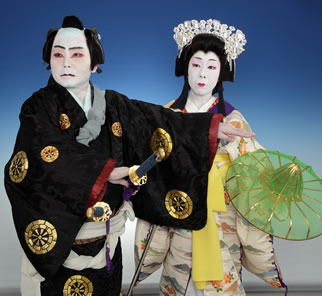Towson University’s Asian Arts and Culture Center presents Kabuki Dance by Bando Kotoji

Towson University’s Asian Arts and Culture Center presents Kabuki Dance led by the famed master dancer Bando Kotoji in Stephens Hall Theatre, located at 8000 York Road on the campus of Towson University on Sunday, April 1 at 7:30 p.m. From his vast repertoire, Kotoji has selected vibrant dances for this performance including the celebratory Sanbaso dance; Cho No Michiyki (The Last Journey of Two Butterflies); the dramatic and tragic dance Tamatorie Ama (The Pearl Diver); and Yoshino-yama (Yoshino Mountain) famous for its magnificent cherry blossoms. The dancers will be accompanied by two chanters and four musicians. Bando Kotoji’s five-city North American tour is co-produced by Japan Society and The Japan Foundation in celebration of the 100th Anniversary of Japan’s gift of cherry trees to Washington, D.C. and New York City, and supported in part by the Baltimore County Commission on Arts & Sciences and the Maryland State Arts Council.
Kabuki dance is an elegant and refined style of Japanese traditional dance (nihon buyo) borrowed from and inspired by Kabuki theaters repertoire. Kabuki dance students are required to begin training during early childhood in order to master the highly stylized body movements necessary for this art form. After the idea of Western “high-art” was imported into Japan in the late 19th century, a new idea in arts movement began to develop. This idea encouraged Japanese artists to incorporate individual expression into their work. It also aided professional kabuki performers and kabuki practitioners to free themselves from grand kabuki productions as their only way of public presentation. Using traditional kabuki dance techniques, nihon buyo performers have built up a repertoire that now consists of popular sections from kabuki plays as well as pieces inspired by classical noh plays and old folk tales. They have also integrated musical elements from kabuki and bunraku such as shamisen and story-telling chanters.
Today, kabuki is the most popular of the traditional styles of Japanese drama—and its star actors often appear in television or film roles. Interest in kabuki has spread in the West. Kabuki troupes regularly tour Europe and America. Kabuki was inscribed on the UNESCO Intangible Cultural Heritage Lists in 2005.
The Bando School, to which Bando Kotoji belongs, was originated by the Kabuki actor/dancer Bando Mitsugoro III (1775-1832) during the Edo period. Many pupils of Mitsugoro III offered Kabuki Dance lessons to members of wealthy merchant families living in the city of Edo, ultimately resulting in the great prosperity and popularity of the Bando School.
Bando Kotoji began studying Bando School traditional dance under his father and traditional folk dance under his aunt, at the age of six. Since forming his own group in 1981, Bando has regularly performed at venues such as the National Theater and Kabuki-za Theater. Bando has been active in researching and re-staging forgotten traditional repertoire, serving as a commentator for TV and radio programs and collaborating with noh actors, contemporary theater artists and flamenco dancers for joint productions. Throughout his career, Bando has appeared on stage around the world including France, Norway, Russia, South America, Indonesia, Thailand and Korea.
Tickets for the performance are $15 in advance and $20 at the door, $10 for AA&CC members and Towson Students with valid ID. To purchase tickets and for additional information, please call 410-704-2787 or visit www.towson.edu/artscalendar.
|